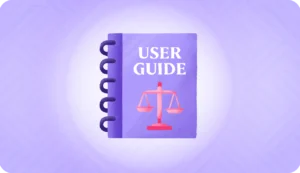Conformity with anti-money laundering (AML) requirements is no longer a regulatory formality. With increasing financial crimes, it is now a non-negotiable compliance requirement to follow. According to reports, approximately $300 billion is laundered annually only through the US. Therefore, strong anti-money laundering (AML) measures are essential. In this regard, AML audits are vital for ensuring your financial institution effectively combats terrorist financing, funding, and money laundering.
In this article, we will go over the details, discuss recommended practices, and then explain how automation might make things easier.

What is an AML audit?
An AML audit is a third-party evaluation of your organization’s anti-money laundering procedures. The audit results will indicate how well internal controls, policies, procedures, and processes can detect and prevent money laundering. Think of it as an intense examination to find the loopholes in your AML compliance shield.
Why is AML audit essential for organizations?
There are several advantages to doing AML audits:
Guarantee Adherence: Compliance with anti-money-laundering (AML) standards and regulatory requirements established by SROs such as the National Futures Association (NFA) and FinCEN is confirmed through audits. Using this measure, organizations can avoid substantial penalties and harm to their reputation due to noncompliance.
Spot vulnerabilities: By conducting an independent audit of your AML program, you can find any weaknesses and fix them to make your defenses more robust against financial crime.
Increase efficiency level: Auditors lay the groundwork for an annual AML audit program that is stronger and more efficient by identifying problematic areas.
Strong brand value: If your AML audit goes well, authorities and prospective clients will see you are serious about anti-money laundering compliance. It eventually strengthens the company’s brand image.
What is the difference between AML audits and financial audits?
Although anti-money laundering and financial audits are different, both check for correctness and compliance. Here are some key differences.
Purpose: The goal of a financial compliance audit is to check that your financial statements are accurate and follow GAAP (Generally Accepted Accounting Principles). However, anti-money laundering audits examine your program in detail to ensure it is effective in identifying and preventing money laundering.
Process: Common components of financial audits include looking into previous transactions and checking the effectiveness of internal controls pertaining to financial reporting. However, anti-money-laundering audits look at your Know Your Customer(KYC) processes, customer due diligence (CDD), financial risk assessments, systems for monitoring transactions, and AML-related staff training.
Benefits: Financial audits primarily ensure the accuracy of your company’s financial statements for investors and stakeholders. AML audits, however, safeguard institutions from financial crime and potential regulatory sanctions.
Scope: Financial audits focus on your financial statements, but AML audits examine your entire AML procedure.

The AML audit checklist
For an AML audit to be successful, a clearly defined checklist is essential. So what does an independent AML audit consist of? The following critical areas are examined throughout the process of an independent financial statement audit:
Preparing and establishing an audit plan:
- Establish an exact timeframe and scope for the independent audit function.
- Appoint competent and independent AML audit officials to carry out the audit, making sure they are not affiliated with the AML program.
Identity verification and risk assessment of the customer:
- Evaluate your Know Your Customer (KYC) procedures for gathering required information and validating customer IDs, which will help you assess the customer’s financial risks.
- You should check that your customer due diligence (CDD) procedures are adequate in light of the threats that have been identified.
- Check that your risk assessment processes correctly classify clients according to the likelihood that they may engage in money laundering or terrorist funding.
Transaction monitoring:
- Make sure your AML transaction monitoring system can identify unusual activities.
- Determine how well the system can detect suspicious activity and quickly generate Suspicious Activity Reports (SARs).
Internal controls:
- Examine if your company’s internal controls are in place to identify and stop money laundering.
- Please ensure these measures are well-documented, implemented, and regularly reviewed to determine their effectiveness.
Recordkeeping and reporting:
- The reporting and recordkeeping processes should be reviewed to adhere to the data retention rules set out by AML.
- The proper and timely submission of Suspicious Activity Reports (SARs) to the appropriate authorities must be reviewed and confirmed.
AML training testing and evaluation:
- Find out how well your program trains staff to spot and report questionable deals.
- Determine how familiar your staff is with AML compliance and how well they understand their duties.
Examine past audits:
- Identify any unresolved issues by reviewing past independent AML audit reports and ensuring corrective actions have been performed.
- Determine where your AML program is succeeding and where it needs work by analyzing relevant trends.
Who needs to conduct an AML audit?
At regular intervals, AML audits must be carried out by financial institutions that are obligated to comply with AML regulations and legislation. The following are included:
- Banks
- Financial cooperatives
- Financial advisors and companies that provide financial services, including insurance
What is the frequency of AML auditing?
Size, risk profile, and legal mandates all play a role in determining the exact frequency of audits. On the other hand, our financial institutions often perform AML audits once a year or twice a year.
The elements that determine how often an AML audit is conducted are as follows:
Institution size: Generally, audits occur more frequently at larger institutions that handle more complex operations and have lower transaction volumes.
Risk profile: An increased frequency of audits may be imposed on institutions considered high-risk owing to potential risks due to their clientele or the products they sell.
Regulations requirements: Periodic audits may be required of particular institutions under FinCEN, the NFA, or other SRO requirements.
There is room for improvement in your AML program; while regulations provide a starting point, more risk-based audits can be conducted. As a result, you may show that you’re proactive about complying with rules and making changes as needed to match new risks.
Automating the AML audit to ensure compliance
Due to the large amount of data involved with the AML audit requirements and compliance, manual audits can be daunting and time-consuming. The application of AI solutions can revolutionize this situation. AML audit tools powered by artificial intelligence can:
Seamless and time-saving: Saving time and effort, AI may automate data extraction, analysis, anomaly detection, and streamlining data processing.
Better risk assessments: AI systems can examine client information and spending habits to spot suspicious behavior more precisely.
Efficient and quick compliance reporting: Highly effective and efficient compliance reporting is possible with AI, which can automate the creation of comprehensive compliance AML audit reports.
HyperVerge: The ideal solution for automated AML audits
HyperVerge offers advanced, independent AML audits and solutions powered by artificial intelligence. You can easily standardize AML audits and guarantee ongoing compliance with the state-of-the-art technology-loaded platform.
Here are some ways HyperVerge can help you:
Automated Know Your Customer (KYC) and customer due diligence (CDD): HyperVerge streamlines the KYC compliance procedures by automating client onboarding and customer due diligence (CDD).
High-Tech transaction monitoring: With the help of artificial intelligence, the Hyperverge system keeps a constant eye out for any questionable transactions, reducing the likelihood of false positives and human mistakes.
Real-time risk assessment: HyperVerge allows for optimal resource allocation through real-time risk assessment, which dynamically evaluates client risk profiles using data collected today.
Convenient reporting: Effortlessly produce detailed AML audit reports, facilitating seamless interaction with regulatory bodies’ previous audit reports.
Embrace AI-powered solutions like HyperVerge to turn AML audits into a benefit to boost your compliance posture rather than a burden.
Final words
To prevent laundering, it is crucial to conduct thorough AML audits. From their aim to best practices, this article has prepared you with a complete grasp of AML audits. The ability to keep ahead of financial crime concerns and maintain a solid AML compliance program is enhanced when your institution conducts regular audits and makes use of automation solutions like HyperVerge.
For more information about how HyperVerge’s AI-powered solutions can simplify your AML audits and guarantee continuous compliance, contact us today.





















